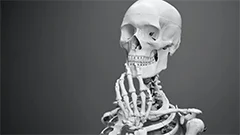Introduction
The sacrum is a triangular-shaped bone located at the base of the spine in vertebrates, particularly mammals. In humans, it is one of the largest and most robust bones of the skeleton, playing crucial roles in maintaining posture, providing attachment sites for muscles, ligaments, and articulations with neighboring vertebrae. This course aims to provide a comprehensive understanding of the sacrum's anatomy, function, development, and clinical relevance within the context of osteology.
Anatomical Location
The sacrum is situated between the lumbar vertebrae (lower part of the spinal column) and the coccyx (tailbone). It articulates with the ilium (hip bone) at the sacroiliac joint, forming part of the pelvis. The sacrum is divided into five fused vertebrae, which we will explore in detail in the subsequent sections.
Sacral Vertebrae
The sacral vertebrae are not independent units but instead are fused together to form a single bone. Each individual sacral vertebra exhibits distinct characteristics that are essential for understanding the overall structure and function of the sacrum.
Anatomy of Individual Sacral Vertebrae
Each sacral vertebra can be described in terms of its morphological features, including the following:
- Shape: Each sacral vertebra has a wedge-like shape with concave anterior and posterior surfaces, resembling a biconvex lens.
- Facets: Each sacral vertebra has superior and inferior articular facets that allow articulation with neighboring vertebrae. The inferior facets also participate in the formation of the sacroiliac joint with the ilium.
- Centrum: The centrum refers to the central body of the vertebra, which is somewhat narrower than that of other vertebrae due to the fusion process.
- Transverse processes: These processes are rudimentary or absent in sacral vertebrae compared to other vertebrae.
- Spinous process: The spinous process is short, broad, and flat in sacral vertebrae.
Fusion Process
The fusion of the individual sacral vertebrae begins during fetal development and continues throughout life. The degree of fusion varies between individuals but is generally complete by the time an individual reaches adulthood. This process results in the characteristic triangular shape of the sacrum and creates a strong, rigid structure that can support the weight of the upper body and transmit forces to the pelvis during locomotion.
Functions of the Sacrum
The sacrum plays several critical roles within the human skeleton:
- Postural Support: The sacrum helps maintain an upright posture by connecting the lumbar vertebrae with the pelvis, forming a stable base for the spine.
- Articulation: The articulations between the sacral vertebrae and neighboring vertebrae (lumbar and coccygeal) allow flexibility and movement in various directions, contributing to overall spinal mobility.
- Attachment Sites: The sacrum serves as an attachment site for numerous muscles, ligaments, and other soft tissues, including the powerful gluteus maximus and piriformis muscles.
- Pelvic Stability: The sacroiliac joint between the sacrum and ilium provides stability to the pelvis, particularly during weight-bearing activities such as walking or standing.
Clinical Relevance of the Sacrum
Due to its location and role in maintaining posture and supporting the weight of the upper body, the sacrum is susceptible to various pathologies and injuries. Common clinical issues associated with the sacrum include:
- Sacroiliac Joint Dysfunction: This condition can cause pain, inflammation, and restricted movement at the sacroiliac joint, often resulting from trauma or repetitive strain.
- Herniated Sacral Disc: A herniated disc in the sacrum can put pressure on nearby nerves, causing lower back pain, numbness, tingling, or weakness in the legs.
- Fractures: Fractures of the sacrum are typically the result of high-energy trauma, such as a car accident or fall from a significant height.
Conclusion
The sacrum is an essential bone in the human skeleton, playing crucial roles in maintaining posture, providing attachment sites for muscles and articulations with neighboring vertebrae, and contributing to pelvic stability. Understanding the anatomy, development, and functions of the sacrum can help medical professionals diagnose and treat related pathologies effectively.
MCQ: Test your knowledge!
Do you think you know everything about this course? Don't fall into the traps, train with MCQs! eBiologie has hundreds of questions to help you master this subject.
These courses might interest you
Create a free account to receive courses, MCQs, and advice to succeed in your studies!
eBiologie offers several eBooks containing MCQ series (5 booklets available free for each subscriber).



